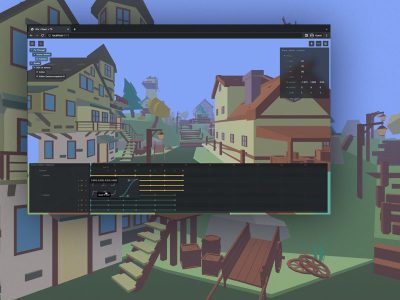From our sponsor: Leverage AI for dynamic, custom website builds with ease.
In this tutorial we are going to create a great menu with some content area that slides out. We use the grunge style because we want it to look a bit messy: the menu items are going to have a random rotation using the CSS3 property “transform”. So, when we load the page each menu item will be positioned differently, giving a random and creative look to this grunge page.
The content area is going to be visible in the beginning, but slide out and back in everytime another menu item is clicked. Also, we will be randomizing the rotation degree of the content area.
Please note that the rotation effect will not work in IE or any other browers that does not support standa..ehm CSS3 yet.
The Resources
Let’s first start with the images that we need for this tutorial. You can find some nice paper backgrounds here (please check the rights of each download source):
http://www.creativecloseup.com/30-great-free-paper-backgrounds-and-textures
I used the first one which can also be directly found here:
http://www.flickr.com/photos/playingwithpsp/2583644089/sizes/o/
And background image for the menu items can be found here.
The Markup
We will start with the markup of the content area:
<div id="content"> <div id="home" class="text"> <!-- Write your content here --> </div> <div id="about" class="text" style="display:none;"> <!-- Write your content here --> </div> <!-- Other content items --> </div>
The menu will have the following markup:
<ul id="navigation"> <li class="home"><a title="Home">Home</a></li> <li class="about"><a title="About">About</a></li> <li class="search"><a title="Search">Search</a></li> <li class="photos"><a title="Photos">Photos</a></li> <li class="contact"><a title="Contact">Contact</a></li> </ul>
The CSS
The content div and the inner element will have the following style:
#content{
width:824px;
height:600px;
margin:-200px auto 0px auto;
background:transparent url(bg.gif) no-repeat bottom left;
}
#content h1{
color:#7F6137;
text-shadow:1px 1px 1px #fff;
}
#content p{
margin:20px;
width:600px;
}
#content .text{
padding:300px 0px 0px 100px;
}
So, the content area is going to have the paper background and the top is going to be hidden. That we achive by setting the margin to a negative value: we full the content area up outside of the visible window.
The menu is going to have the following styling:
ul#navigation {
position: fixed;
margin: 0px;
padding: 0px;
top: 0px;
right: 200px;
list-style: none;
z-index:999999;
}
ul#navigation li {
display:inline;
float:left;
width:100px;
margin-left:1px;
}
ul#navigation li a {
display: block;
font-weight: bold;
text-shadow: 1px 1px 1px #fff;
float: left;
width: 100px;
height: 35px;
color: #603d05;
background: transparent url(item.png) no-repeat bottom right;
text-decoration:none;
text-align: center;
padding-top: 80px;
margin-top: -40px;
cursor: pointer;
}
Since we will make the menu items slide out a bit when we hover over them, we initially set the top margin to a negative value. The navigation list itself will be fixed, which means that even if you have more content to scroll, it will always be at the top of the page.
In browsers where the scroll just appears when the content gets bigger, you might want to set some initial height of the body in order to avoid the menu moving.
Let’s add some magic!
The JavaScript
Here is the JavaScript function that will add all the magic:
$(function() {
var d=300;
$('#navigation a').each(function(){
var $this = $(this);
var r=Math.floor(Math.random()*41)-20;
$this.css({
'-moz-transform':'rotate('+r+'deg)',
'-webkit-transform':'rotate('+r+'deg)',
'transform':'rotate('+r+'deg)'
});
$('#content').css({
'-moz-transform':'rotate('+r+'deg)',
'-webkit-transform':'rotate('+r+'deg)',
'transform':'rotate('+r+'deg)'
});
$this.stop().animate({
'marginTop':'-70px'
},d+=150);
});
$('#navigation > li').hover(
function () {
var $this = $(this);
$('a',$this).stop().animate({
'marginTop':'-40px'
},200);
},
function () {
var $this = $(this);
$('a',$this).stop().animate({
'marginTop':'-70px'
},200);
}
).click(function(){
var $this = $(this);
var name = this.className;
$('#content').animate({marginTop:-600}, 300,function(){
var $this = $(this);
var r=Math.floor(Math.random()*41)-20;
$this.css({
'-moz-transform':'rotate('+r+'deg)',
'-webkit-transform':'rotate('+r+'deg)',
'transform':'rotate('+r+'deg)'
});
$('#content div').hide();
$('#'+name).show();
$this.animate({marginTop:-200}, 300);
})
});
});
In the beginning we generate a random number from -20 to 20 which will be our degree of rotation. Each menu item and the content will initially be rotated randomly. When we hover over the menu items, they will slide out a bit, and slide back in when the mouse is moved out.
Whenever we click on one of the menu links, the according inner content element gets shown. Also, the content area slides in and back out while changing it’s degree of rotation.
And that’s it? Absolutely!
By the way, it’s rendered very nicely in Chrome!
Enjoy it!






Wow, amazing! I keep on refreshing the demo page to see the menu rotate around! Thx
Great article!
Hi,
Could you please give me permission to use this template and script for my personal website. It contains about myself, portfolio of my projects and my resume.
Hi Revanth,
you don’t have to ask permission, everything we do here can be used for free! Let us know, when you set it up, we’d love to see it in action 🙂
I wish you the best, cheers,
ML
Hi Mary,
Thank you. I will setup and let you know
Great !
I love this trick. make a living website, or just little different at each visite
Hello,
great work. Wonderfull jQuery tutorials on your site…
Greetings from de
Nice. That’s my font, too 🙂
How would you get the web page to load on an angle in Internet Explorer, like it does in Fire Fox?
Thanks,
Sam
That’s good. Thank you very much for the nice totorials!!!
But (always this “but’)
I did everything like you recommended in this article (Grungy Random Rotation Menu with jQuery and CSS30). But it doesn’t work. I see the background and menu when I’m clicking the menu item I can see only background and nothing else. No menu no div text. Can you advise me where I was wrong. I used adobe go live v.7.0.0135 and tested my work in Google Chrome.
Thanks a lot! It’s working now!!!!
Hey,
very cool tutorial but i have a big problem.
I want to create the content area and use some div-tags to have some more options than just with p-tags and and div tags are not displayed. Why is that?
Thanks a lot and very helpful and wonderful project!
awesome….your r great mary…..luv u lot..
If someone has a solution for the css selector onclick function to show div’s not just p’s could you please post it.
Is there a way to make this a verticle navigation on the left side of the screen? It would be much apprecaited if any one could help with that.
Nice….I enjoyed a lot……/